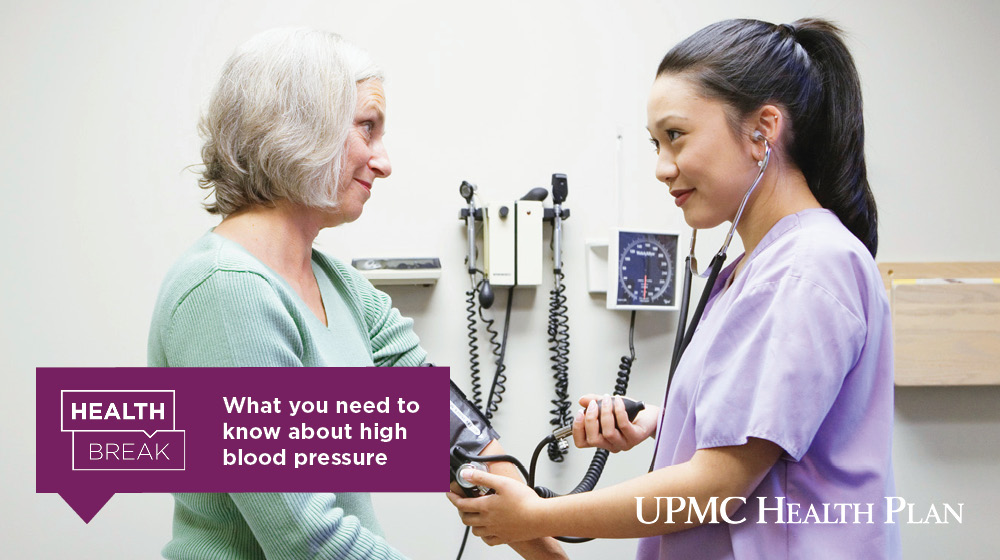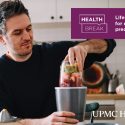Health Break: What you need to know about high blood pressure

A podcast for UPMC Health Plan members, Health Break is your quick guide to caring for your mental and physical health, prioritizing wellness, and making the most of your health insurance plan.
Episode 10: Take a Health Break with Dr. Kalpana Char
Dr. Char takes a Health Break with us to explain blood pressure, what we need to know about high blood pressure, and how to treat high blood pressure with help from your primary care provider.
Episode transcript:
Camille: Welcome to Health Break by UPMC Health Plan, your quick guide to health, wellness, and how to make the most of your health insurance plan. Listen during your coffee break, lunch break, or anytime you need a break. I’m your host, Dr. Camille Clarke-Smith. I help to oversee the quality of the plans we offer at UPMC Health Plan.
Alex: And I’m your co-host, Alex Treanor. I’m a senior health coach who works with our members on healthy lifestyle habits and goals. This is your… Health Break.
Alex: Hey everyone! I’m Alex Treanor. Today we’re getting a download on blood pressure and hypertension from Dr. Kalpana Char. We’ll find out why it’s important to monitor your blood pressure and how your primary care provider can help you do it.
Thank you so much, Dr. Char, for taking a Health Break with us today.
Dr. Char: Thanks for having me. Happy to talk about this important topic.
Alex: To get us started, can you explain, what is blood pressure?
Dr. Char: Yeah, so great question. Let’s start just reviewing what our circulation looks like in our body. There is always blood flowing through our arteries, and the heart pumps the blood through the arteries, so that we get nutrients and oxygen to all of our vital organs. Now, when I say vital organs, I mean things like our heart, brain, kidney, lungs, and just about every part of our body. So it’s a really, really important function. The force of that blood flow that’s inside the arteries is called your blood pressure. Now this blood pressure is measured with two numbers. You’ve probably heard of a top number and a bottom number. The top number is your systolic blood pressure, which is the blood pressure during an active heartbeat, and the bottom number is your diastolic blood pressure, and this is between heartbeats when the heart is relaxed, and the top number is always higher than the bottom number.
A normal blood pressure reading might be 120 over 70. During the course of the day, the blood pressure can go up, it can go down, just based on what we’re doing. So me running up a flight of stairs would make my blood pressure go up. And when I’m sleeping at night, my blood pressure would be lower. And this is a normal, expected change. When we measure blood pressure, we can either use a home device, which you’ve probably seen at the drug store, or when you go to your doctor’s office or your primary care provider’s office, there might be a machine or they might use a manual cuff. Ideally the blood pressure should be checked when we’re sitting, relaxed, take a few deep breaths just to get the best reading possible. If it’s high, we should stop, again, relax, take a few deep breaths, and recheck it, but you should have a routine blood pressure check as part of your annual medical visit.
Alex: You mentioned blood pressure readings—what reading would be considered high blood pressure?
Dr. Char: Another great question. Here’s some key numbers you should know. If you’re at your doctor’s office or a medical clinic, then a systolic reading, or the top number, being over 140, or the diastolic pressure, or bottom number, over 90, is considered high. If you’re taking a home reading or you’re at a health fair in the community, a systolic pressure over 135 or a diastolic blood pressure over 85 is considered high.
If you have at least a couple of these readings that are elevated on separate occasions, then your primary care provider might diagnose you with hypertension. Hypertension is a very common condition and it affects more than half of all adults over the age of 50. And it disproportionately affects the black population. Because it’s that common, it’s very important that all adults be screened regularly with routine blood pressure checks.
Alex: Why should we be mindful of high blood pressure?
Dr. Char: Yeah, so this is a really important point. Elevated blood pressure for long periods of time can cause damage in our arteries, and often this goes undetected. So you may have no symptoms when your blood pressure is high and damage could be going on on the inside of your arteries. Now, what happens with that is it affects the organs that these arteries supply, so important organs like your heart, brain, kidneys, or eyes, just to name a few, might have long-term effects. This is how you end up with a stroke or heart attack after having untreated hypertension for years and not even realizing it. Sometimes you can have some symptoms, some people have minor headaches or dizziness. Others might have more severe symptoms like chest pain, severe headaches, or sudden vision loss—and these are things you should tell your doctor or your primary care provider about right away.
Alex: Can you talk a little bit about how high blood pressure can be treated?
Dr. Char: The good news is that this is a condition that we can treat effectively and pretty simply. There’s been a lot of research that shows that successful treatment can help reduce strokes and heart attacks, and it’s pretty easy to treat blood pressure problems. Early on before your blood pressure gets to be at the high range there are some things that you can do that don’t involve medications, and these are things like a low salt diet, exercise, weight management, mindfulness practice, quitting smoking, or limiting your alcohol intake. When blood pressure readings are consistently high, meaning over 140 over 90, then you’re probably going to need some medication, in addition to these other lifestyle changes. It’s really important that you follow up with your primary care provider regularly to monitor your blood pressure and treatment if you’ve been diagnosed with high blood pressure.
Unfortunately, a lot of people still go untreated because they either don’t have regular blood pressure screening, or they don’t understand the importance of treatment—so someone might have told them that their blood pressure’s high or their provider may have recommended treatment, yet because they don’t have symptoms, they might choose not to be treated. Some people don’t like taking medication, and others have side effects to prescribed medication. These are some of the reasons that people don’t want to be treated for high blood pressure, but I think these are barriers that we can overcome. If we are able to establish primary care and a relationship with a provider that can meet us where we are with our schedule, our lifestyle, and our values, we can come up with treatment plans that work for us. It’s important to follow up as recommended and work with your provider, and have an open relationship and kind of tell them what problems you might be having if there are barriers to your treatment. That will help you get the best treatment possible for a healthy and active life.
Alex: Thank you so much, Dr. Char, for taking a Health Break with us today to talk about detecting, managing, and treating high blood pressure.
Dr. Char: Thanks.
Alex: Annual physical exams with your primary care provider will always include a check of your blood pressure. Talk to your doctor about your numbers and how to take steps for optimal blood pressure.
Find show notes and more information at upmchealthplan.com/podcast. Join us as we explore other health and wellness topics in the next episode of Health Break.
This podcast is for informational and educational purposes. It is not medical care or advice. Individuals in need of medical care should consult their personal care provider. Views and opinions expressed by the hosts and guests are solely their own and do not necessarily reflect those of UPMC Health Plan and its employees.
Related to this episode:
- Review the American Heart Association guide to understanding blood pressure readings.
- Read essential tips for managing high blood pressure.
- Log in to the UPMC Health Plan member site to choose a PCP.
- View our provider directory to find a PCP near you.
About Dr. Kalpana Char:
Dr. Char is the associate vice president for Special Needs Plan (SNP) Medical Services at UPMC Health Plan. She is a graduate of University of North Carolina School of Medicine and completed her Internal Medicine Residency at University of Pittsburgh Medical Center in 1995. She has spent the past 25 years as a primary care provider with an interest in improving chronic illness management and supportive care for the senior population. In her current role, she continues to support programs and initiatives to enhance the delivery of coordinated, patient-centered care for UPMC Health Plan’s SNP members. Her interests outside of work include live music, travel, and creative projects.
About Dr. Camille Clarke-Smith:

Camille Clarke-Smith, EdD, is a program director in the Quality Improvement, Medicare Stars Department at UPMC Health Plan, where she leads the Medicare Faith and Wellness Program, a 3- to 12-week health and wellness challenge. She is also the founder of the nonprofit Transforming the Health of African American Women (THAW) Inc. She earned a doctorate in health and physical activity education from the University of Pittsburgh in addition to a master’s in exercise science and a bachelor’s in psychology and sociology. She is currently pursuing her master’s degree in social work at Carlow University.
About Alex Treanor:

Alex Treanor is a lead health coach at UPMC Health Plan. As a lifestyle health coach, she specializes in helping you lose weight, eat healthy, get more physical activity, be less stressed, and quit tobacco. Alex has a master’s in Kinesiology, Integrative Wellness from Point Loma Nazarene University. She has been coaching since 2014 and is a Nationally Board Certified Health & Wellness Coach and Certified Personal Trainer. Alex is passionate about helping people improve their relationship with food and exercise while creating healthy, sustainable routines filled with enjoyment. Alex enjoys spending time with her husband, walking with her dog, and eating tacos in the sunshine.



